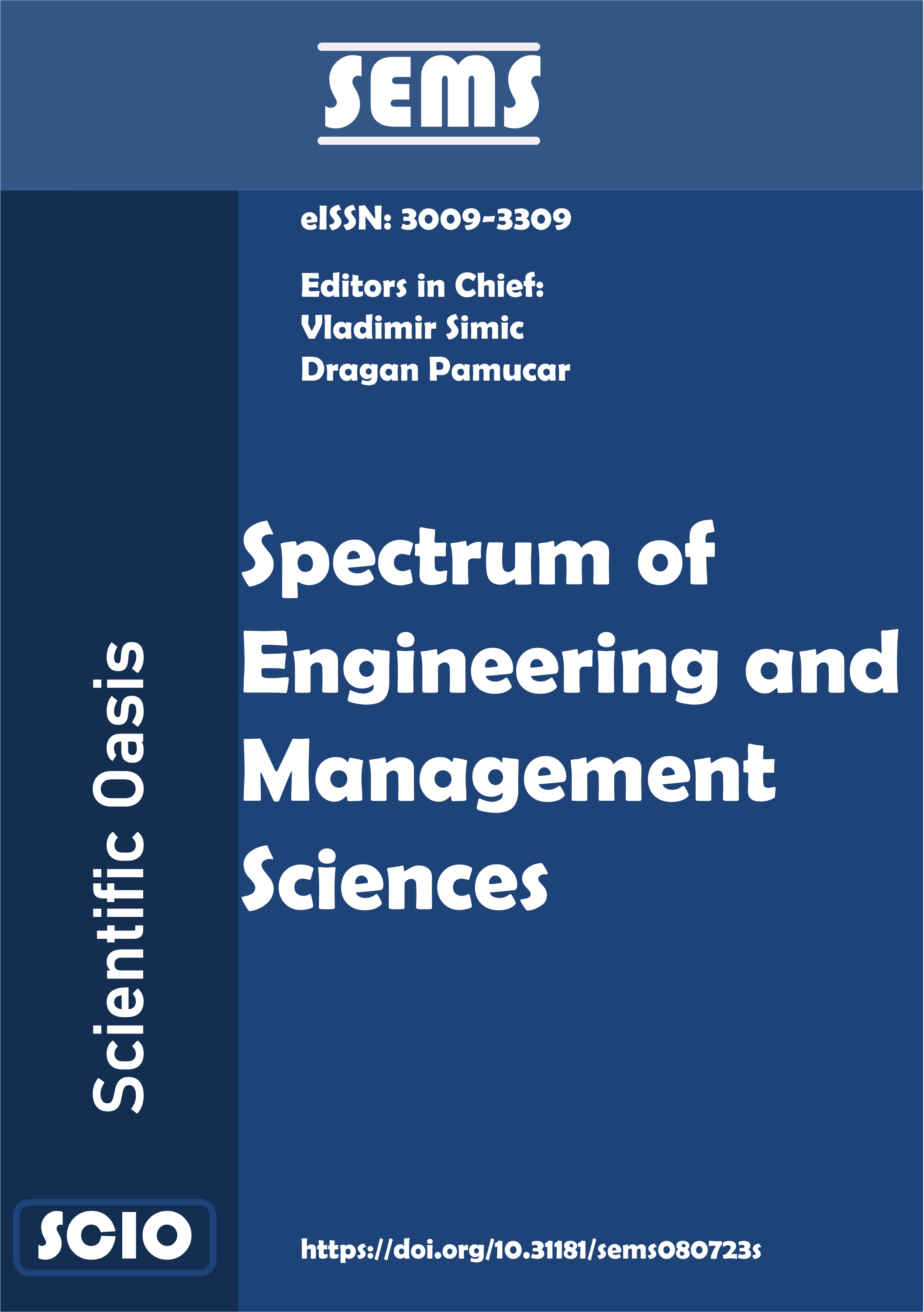Ranking of Autonomous Alternatives for the Realization of Intralogistics Activities in Sustainable Warehouse Systems using the TOPSIS Method
DOI:
https://doi.org/10.31181/sems1120234mKeywords:
Forklifts, AGVs, AMRs, drones, decision-making methods, TOPSISAbstract
The requirement for intralogistics activities to be automated has been impacted by current trends based on the impact of Industry 4.0, the growth of e-commerce, the emergence of the consumer society, the rise in demand for logistics services, etc. Automatization of warehouse intralogistics is fundamental in aiming quickly responds to all user requests. The most common intralogistics equipment in warehouses is the forklift. However, its engagement results in a low level of automation. Consequently, it is useful to implement autonomous technology, such as automated guided vehicles (AGVs), automated mobile robots (AMRs), and drones, to have sustainable intralogistics activities. In addition to advantages and limitations, their application in practice increases performance, adaptability, system efficiency, customer satisfaction, and accuracy and contributes to the efficiency of the entire supply chain. The operating environment is more humane, environmental standards are respected, and certain economic advantages are achieved. These technologies are compared using eight criteria and the technique for order of preference by similarity to ideal solution (TOPSIS) method. AMR was selected as the most suitable option for implementing intralogistics activities. As the automation of intralogistics activities affects the entire supply chain, AMR is the solution that satisfies the social, environmental, and economic requirements of sustainable supply chain management.
References
Weerasinghe, V., & Perera, N. (2022). Intralogistics: making optimized and automated internal logistics and advanced technology attainable.
Ülge, T. A. Ş. (2023). Case Study of Intralogistics in the Framework of Logistics 4.0. International Journal of Automotive Science and Technology, 7(1), 18-24. https://doi.org/10.30939/ijastech..1215381.
Stefanovic, S., Mladenovic, S., & Gošic, A. (2021). Forklift truck as a transport-manipulative means with a practical example of calculating the time of loading vehicles. KNOWLEDGE-International Journal, 49(3), 559-564.
Masis, J., Horvath, L., & Böröcz, P. (2022). The Effect of Forklift Type, Pallet Design, Entry Speed, and Top Load on the Horizontal Shock Impacts Exerted during the Interactions between Pallet and Forklift. Applied Sciences, 12(14), 7035. https://doi.org/10.3390/app12147035.
Ullrich, G., & Albrecht, T. (2022). History of Automated Guided Vehicle Systems. In Automated Guided Vehicle Systems: A Guide-With Practical Applications-About The Technology-For Planning (pp. 1-26). Wiesbaden: Springer Fachmedien Wiesbaden. https://doi.org/10.1007/978-3-658-35387-2_1.
De Ryck, M., Versteyhe, M., & Debrouwere, F. (2020). Automated guided vehicle systems, state-of-the-art control algorithms and techniques. Journal of Manufacturing Systems, 54, 152-173. https://doi.org/10.1016/j.jmsy.2019.12.002.
de Koster, R. B. (2018). Automated and robotic warehouses: developments and research opportunities. Logistics and Transport, 38(2), 33-40. https://doi.org/10.26411/83-1734-2015-2-38-4-18.
Simic, V., Dabic-Miletic, S., Tirkolaee, E. B., Stević, Ž., Ala, A., & Amirteimoori, A. (2023). Neutrosophic LOPCOW-ARAS model for prioritizing industry 4.0-based material handling technologies in smart and sustainable warehouse management systems. Applied Soft Computing, 143, 110400. https://doi.org/10.1016/j.asoc.2023.110400.
Tadić, S., Krstić, M., Dabić-Miletić, S., & Božić, M. (2023). Smart Material Handling Solutions for City Logistics Systems. Sustainability, 15(8), 6693. https://doi.org/10.3390/su15086693.
Ammar, M., Ahmed, M. M., & Abdullah, M. (2022). A Chain-Driven Live Roller Mechanism for Loading and Unloading Packages on Autonomous Mobile Robots in Warehouses. Industrial Cognitive Ergonomics and Engineering Psychology, 35, 46. https://doi.org/10.5491/ahfe1001600.
Löffler, M., Boysen, N., & Schneider, M. (2023). Human-Robot Cooperation: Coordinating Autonomous Mobile Robots and Human Order Pickers. Transportation Science, 57(4). https://doi.org/10.1287/trsc.2023.1207.
Szalanczi-Orban, V., & Vaczi, D. (2022). Use of Drones in Logistics Options in Inventory Control Systems. Interdisciplinary Description of Complex Systems, 20(3), 295-303. https://doi.org/10.7906/indecs.20.3.9.
Maghazei, O., & Netland, T. (2020). Drones in manufacturing: Exploring opportunities for research and practice. Journal of Manufacturing Technology Management, 31(6), 1237-1259. https://doi.org/10.1108/JMTM-03-2019-0099.
Dabic-Miletic, S. (2023). Autonomous vehicles as an essential component of industry 4.0 for meeting last-mile logistics requirements. Journal of Industrial Intelligence, 1(1), 55-62. https://doi.org/10.56578/jii010104.
Bányai, T. (2023). Energy Efficiency of AGV-Drone Joint In-Plant Supply of Production Lines. Energies, 16(10), 4109. https://doi.org/10.3390/en16104109.
Aydın, S., & Kahraman, C. (2014). Vehicle selection for public transportation using an integrated multi criteria decision making approach: A case of Ankara. Journal of Intelligent & Fuzzy Systems, 26(5), 2467-2481. https://doi.org/10.3233/IFS-130917.
Plebani, M., Sciacovelli, L., Aita, A., Pelloso, M., & Chiozza, M. L. (2015). Performance criteria and quality indicators for the pre-analytical phase. Clinical Chemistry and Laboratory Medicine, 53(6), 943-948. https://doi.org/10.1515/cclm-2015-7000.
Winkelhaus, S., Grosse, E. H., & Glock, C. H. (2022). Job satisfaction: An exploratory study on changes in the work characteristics of employees in Intralogistics 4.0. Journal of Business Logistics, 43(3), 343-367. https://doi.org/10.1111/jbl.12296.
Akcelik, R., & Besley, M. (2003.). Operating cost, fuel consumption, and emission models. In aaSIDRA and aaMOTION. In 25th conference of Australian institutes of transport research (pp. 1-15). University of South Australia Adelaide, Australia.
Chryssolouris, G. (1996). Flexibility and its measurement. CIRP Annals, 45(2), 581-587. https://doi.org/10.1016/S0007-8506(07)60512-5.
Bošković, S., Švadlenka, L., Jovčić, S., Dobrodolac, M., Simić, V., & Bačanin, N. (2023). An Alternative Ranking Order Method Accounting for Two-Step Normalization (AROMAN)–A Case Study of the Electric Vehicle Selection Problem. IEEE Access, 11, 39496-39507. https://doi.org/10.1109/ACCESS.2023.3265818.
Downloads
Published
Issue
Section
License
Copyright (c) 2023 Scientific Oasis

This work is licensed under a Creative Commons Attribution-NonCommercial-NoDerivatives 4.0 International License.













